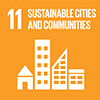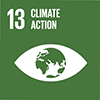Description/achievement of initiative
The Urban-LEDS Project, funded by the European Comission, supports development and implementation of urban low emissions development strategies (LEDS) to address climate change in partnership between UN-Habitat and ICLEI. The objective of the Project is to enhance the transition to low emission urban development in four emerging economy countries, Brazil, Indonesia, India and South Africa. In each of those countries the project supports two Model Cities, receiving intensive assistance to develop LEDS, plus four to six 'Satellite Cities' that engaged to a lesser degree. A handful of European cities served as resource cities to support technology transfer.
Implementation methodologies
Programme implementation has focused on capacity building and training to build a solid base for LED strategy development. ICLEI World Secretariat and its Regional Offices are the principal implementing offices of the Urban-LEDS Project. UN-Habitat has administrative responsibilities and participated in focused technical activities through associated project support. Each of the Country Teams successfully followed a similar Project implementation start up process. The Project objective is to be accomplished through the preparation of LED strategies in Model Cities and where possible in Satellite Cities through capacity building, city-to-city exchanges, hands-on actions including emissions inventories to identify priority areas for interventions, and to understand, assess, design, and implement LED technical and behaviour change action activities in target cities. In each of the Project countries the approaches are comprehensive and strategic, designed to build the political and technical base for sustainable low emissions development initiatives by programmatically engaging mayors, key personnel in local and national government and technical support organizations and the civil society. Staff recruiting was accomplished through existing ICLEI Regional Office staff and contracting additional personnel to fill positions in required areas of technical expertise. “Champion” cities have been identified and support is provided to them as the face of innovation and project development.
Arrangements for Capacity-Building and Technology Transfer
The LED transition is being accomplished through policy and practice – preparation of LED strategies and demonstration projects; guidance provided by ICLEI methodologies, training and capacity building based on the ‘GreenClimateCities’ (GCG) 27 steps; training in emissions inventory skills, sustainable procurement and waste management, energy efficiency in street lighting and municipal buildings, low emissions mobility planning and building climate change awareness and understanding; employing the Solutions Gateway; sponsoring national and international exchanges and study tours; and from understanding that the project was to function in a vertically integrated manner. Study tours have broadened the perspective of partners and local officials through international travel to sel ected European cities and cities in their regions. The following core training has been carried out for ICLEI and Model City staff, national government, NGOs and private sector partners. The training events include:The new Global Protocol for Community-Scale Greenhouse Gas Emission Inventories (GPC) and - HEAT+ training – Harmonized Emissions Analysis Tools plus – software to support local GHG and air pollution emission reduction planning, 23-24 September 2013 led by DNPI National Council for Climate Change, Jakarta, Indonesia for all ICLEI staff & city staff. - GRIP training – Greenhouse Gas Regional Inventory Process – tool to help cities explore energy & GHG emission reduction scenarios, November 2013 in Nelson Mandela Bay, South Africa (ICLEI staff and interested cities).- CLIMACT Prio – Climate Actions Prioritization – tool for screening and prioritizing local climate change actions, April 2014 in Hannover, Germany (ICLEI staff).
Coordination mechanisms/governance structure
In each country, project partners worked closely with the national, regional and local governments, interpreted and benefited from the clarity of purpose of the Project design that focused on strategy development. The Project established a focused vertically integrated programme, and was implemented through a set of seven “Work Packages”. UN-Habitat responsibilities included project management, quality control and M&E to monitor the progress of the Project. The four Project countries have established regular communications between the ICLEI World Secretariat and each other through monthly steering meetings, the Networking Seminars and informally through the Urban-LEDS Website and emails. The secretariat with the different Country Teams monitors progress, provide input on Country Project design and development, partner relationships and critical tools to be employed as part of the Project, especially the ICLEI Tool Kit and the new GPC. The ICLEI Tool Kit and methodologies constitute a major pillar in the Country Team’ Project structures as well as serve as a major support for training, capacity building and substantive input to the partnership frameworks that include government sector offices and departments, private sector entities, LED and Climate Change technical organizations and NGOs and community groups.
Partner(s)
United Nations Human Settlements Programme (UN-Habitat), ICLEI-Local Governments for Sustainability, European Comission, Government of Brazil, Government of South Africa, Partnering local and regional administrations,



 03/2014
03/2014
 03/2016
03/2016
 08/2015
08/2015
 12/2014
12/2014
 Time-frame: 03/2013 - 03/2016
Time-frame: 03/2013 - 03/2016